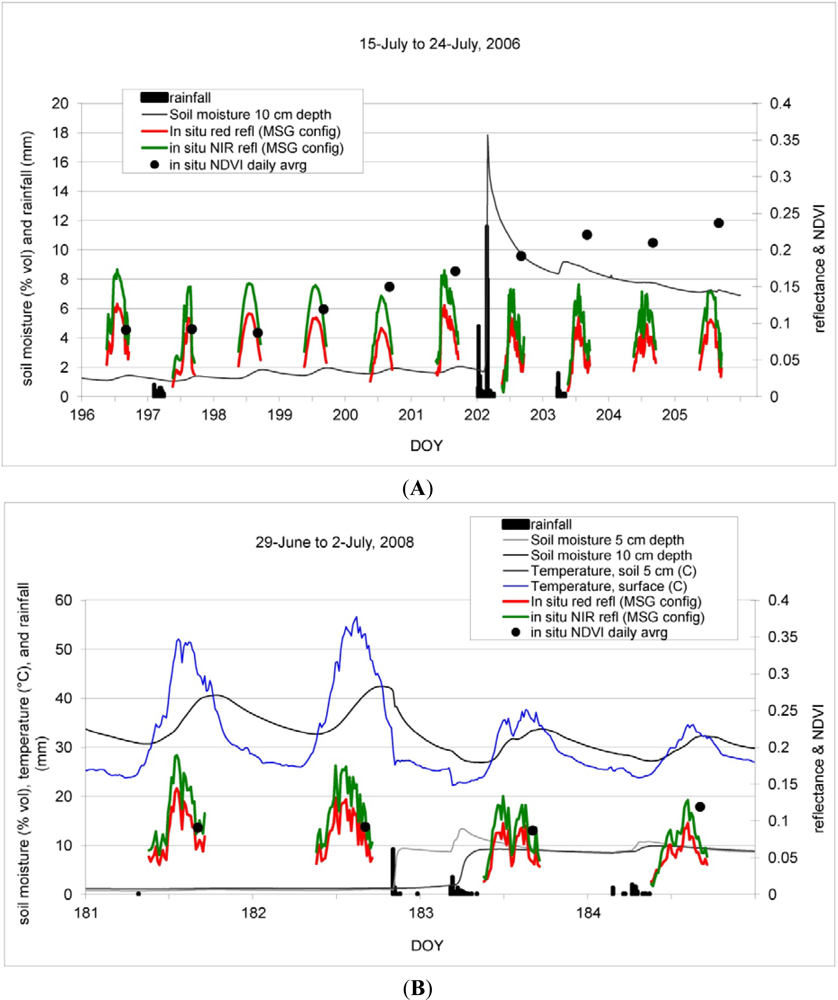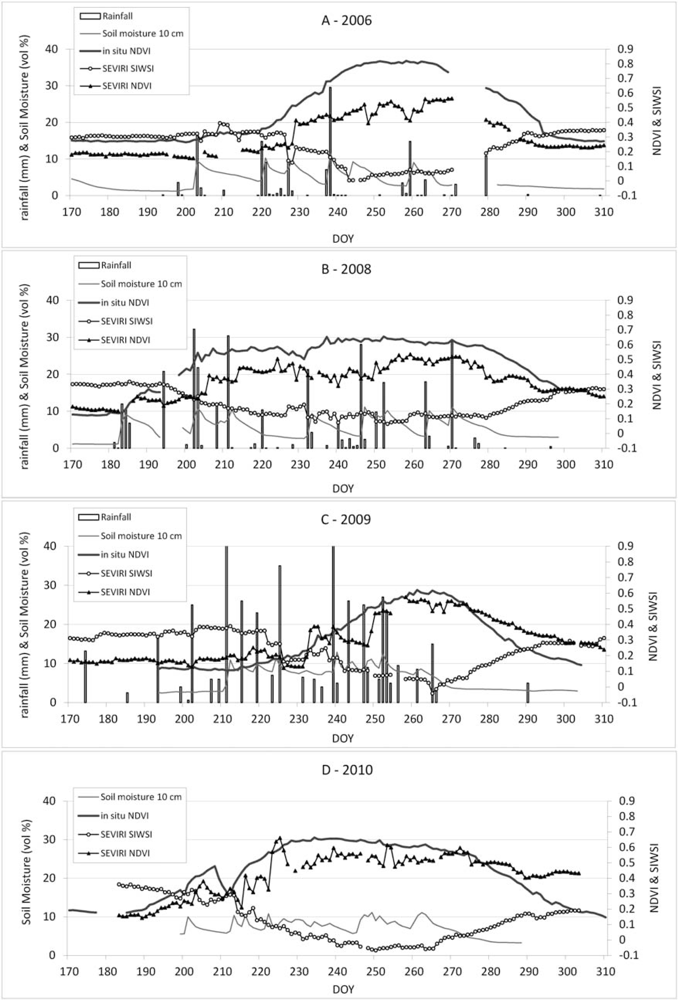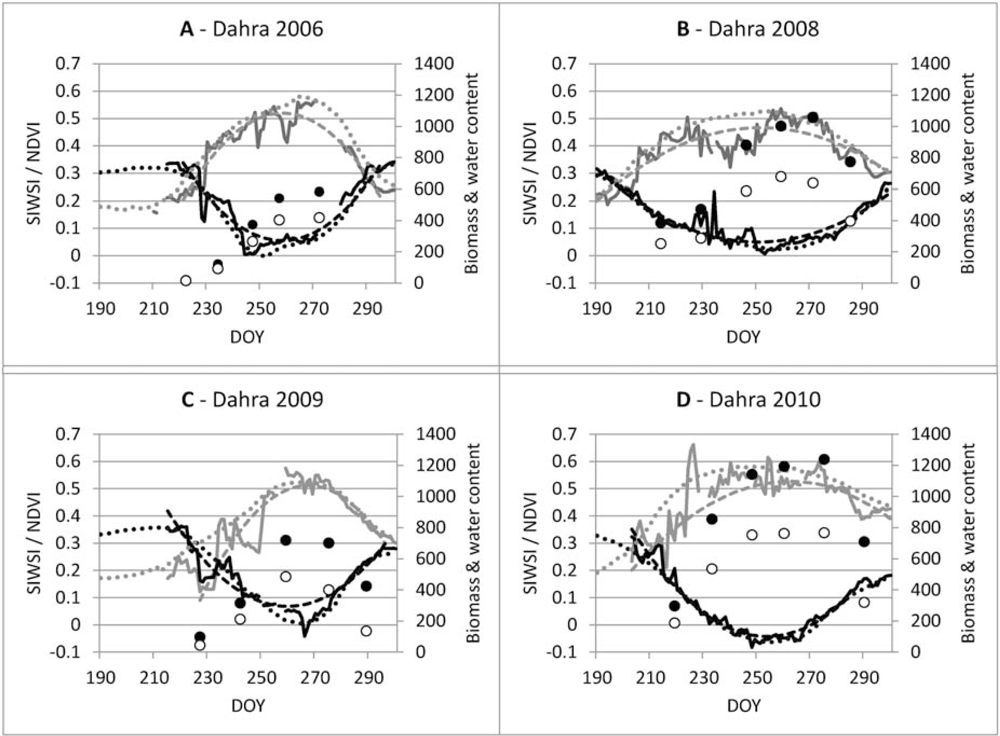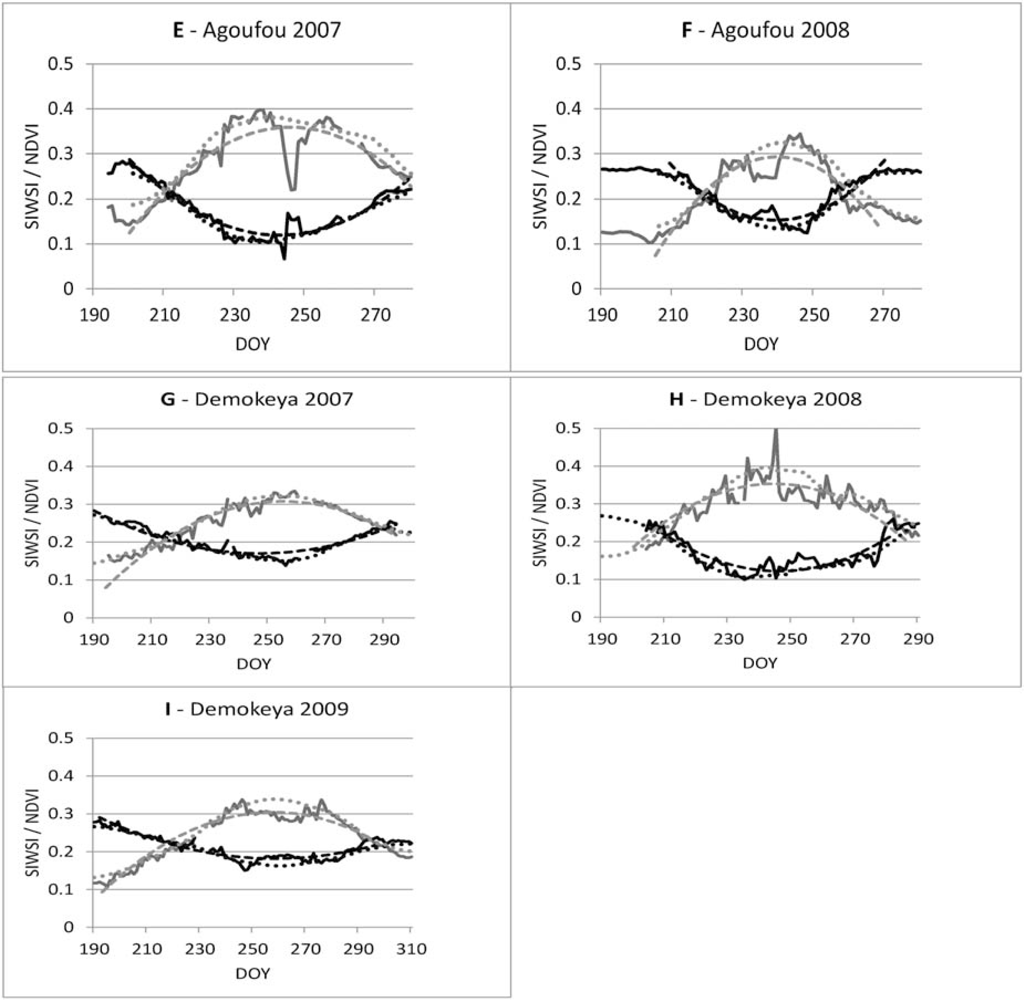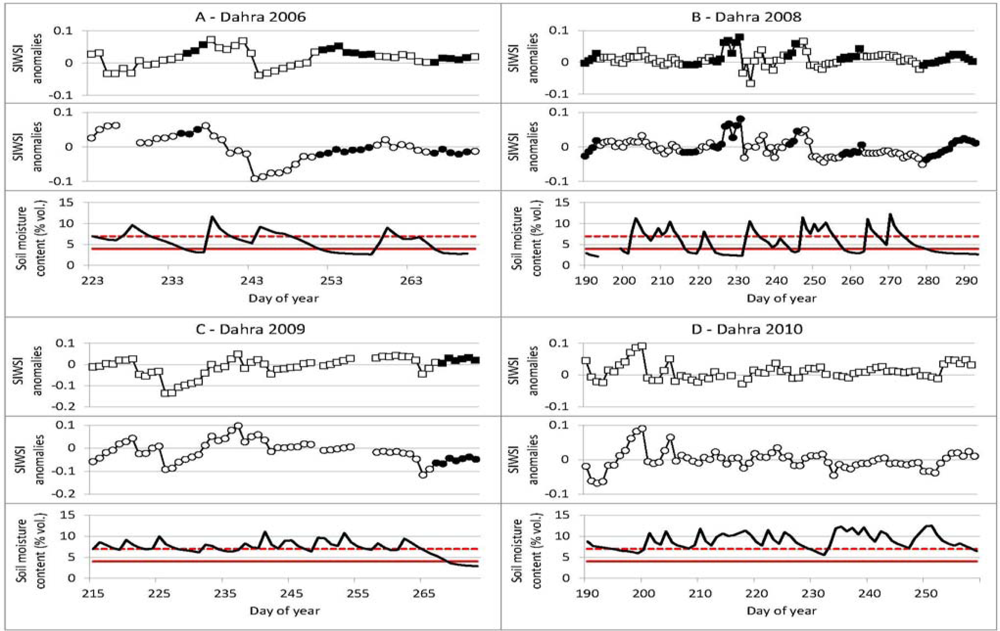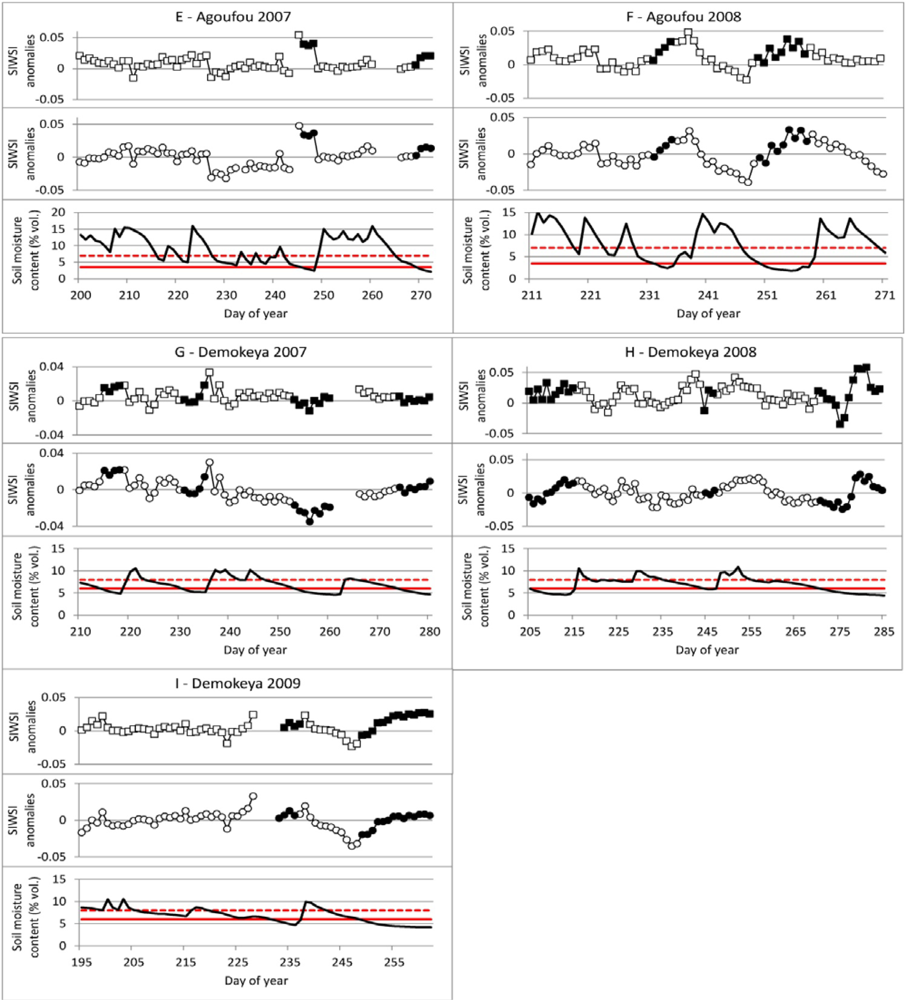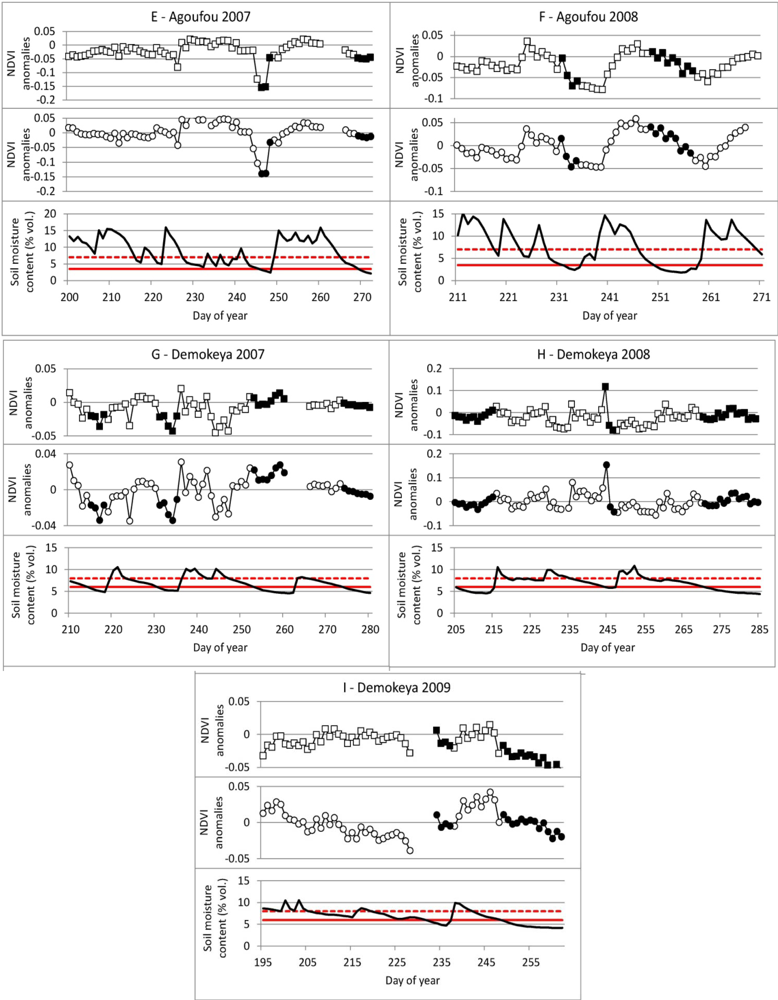6.1. Land Surface Moisture during Period of Bare Soil
Dahra
in situ data from the pre-growing season periods of bare soil reflectances in 2006 and 2008 are shown in
Figure 2. The rainfall events during the 2006 bare soil period (
Figure 2(A)) all occur between late afternoon and early morning. The smaller rainfall events on DOY 197 and 203 have very limited impact on the soil moisture at 10 cm depth, but still appears to initiate germination and greening with NDVI increasing steadily from DOY 199, whereas the 16 mm rainfall on DOY 202 causes an increase in soil moisture to 18 vol.%. Following, the soil moisture decreases to 12 vol.% during the first 3 hours and to 9 vol.% after 24 h. This rapid drain off is due to the sandy properties of the soil, also reflected in the low field capacity (
Table 1). After the initial steep decrease, the soil moisture decreases by less than 1 vol.% per day. During the 2008 period of bare soil (
Figure 2(B)) three rainfall events (total of 29 mm) were registered; DOY 182, 183 and 184, with the first two being only hours apart. As in 2006, the rainfall occurred between late afternoon and early morning, and the SMC followed the same pattern as in 2006, with a sharp increase followed by rapid draining. After ∼24 h the SMC reaches around 8 vol.%–9 vol.%, after which the SMC decrease slows down. The one-hour averaged reflectances for mornings, middays and afternoons on days with night or morning rainfall events (wet days) were lower than on days without preceding rainfall (dry days), with the difference in percent between average reflectance for dry days and average reflectance for wet days being largest on mornings immediately after the rainfall (
Tables 3 and
4). The difference in midday reflectance was not large for 2006, but a noticeable difference in midday reflectance between dry and wet days was observed in 2008. The daily averaged NDVI values calculated from
in situ observations of bare soil conditions is unchanged immediately after rainfall on DOY 197 and 198 in 2006, and DOY 183 in 2008, but are observed to increase from DOY 199 and onwards in 2006, as plant germination and greening initiates. The number of days with reflectance measurements available from bare soil conditions, with variations in soil moisture, was however limited. As shown in
Figure 2(B) the difference in surface temperature for the two dry and two wet days in 2008 was noticeable, especially in terms of diurnal temperature range. This changes from 28 °C and 30 °C for DOY 181 and 182 respectively, to 15 °C and 10 °C for DOY 183 and 184, while the diurnal range in soil temperature at 5 cm depth is 10 °C and 12 °C for DOY 181 and 182, and reduced to 7 °C and 5 °C on DOY 183 and 184.
The short term changes in red and NIR reflectances, caused by rainfall events during the two periods of bare soil (
Figure 2), are congruent with the short term albedo variability caused by rainfall outside of the growing season in the Sahel, as reported by [
28]. The limited time period during which the rainfall induced reflectance changes were observable can be explained by a combination of several factors: (i) timing and quantity of rainfall, (ii) sandy properties of the soil, (iii) high temperatures causing high evaporation rates, and (iv) lack of vegetation. The additional hours of reduced bare soil reflectance observed during the 2008 bare soil case period, as compared to 2006, can be explained by timing and quantity of rainfall. The 2008 precipitation occurred closer to the 9 am morning reflectance measurements, allowing additional hours of measurements where reflectance was noticeable affected. The response in observed surface and soil temperatures in 2008 following the rainfall is very clear with the presence of water decreasing the diurnal temperature range for both surface and soil.
6.2. Land Surface Moisture during Period of Vegetation Growth
Four years of detailed observations covering full growing seasons from Dahra (2006, 2008, 2009, and 2010), are shown in
Figure 3 with
in situ measurements, SEVIRI SIWSI and SEVIRI NDVI. Large inter-annual variations were observed in the growing season onset, length and rainfall quantity and distribution. When comparing the relatively smooth curves of
in situ NDVI time series with the NDVI time series calculated from SEVIRI NBAR product (
Figure 3), it highlights the SEVIRI NDVIs overall lower values and larger noise content. The SEVIRI SIWSI time series appears less noisy as compared to SEVIRI NDVI. This can be due to atmospheric influences, which are larger for shorter wavelengths, as utilized by, e.g., [
30,
57,
58]. Note that the low NDVI in 2009 despite abundant water can be a carryover effect from the fire in late 2008.
In
Figure 4, time series of SEVIRI SIWSI and SEVIRI NDVI growing seasons are shown for all sites together with
in situ measurements of fresh biomass and vegetation water content from Dahra (
Figure 4(A–D)). Second order polynomials and Savitsky-Golay filter for detrending are fitted to the SIWSI and NDVI growing season curves. At Dahra in 2006 and 2009 the water content at peak biomass is approximately the same, although 2009 has more biomass. The SIWSI trend indicates an overall similar curve with comparable minimum values at mid-growing season for these two years. The 2008 growing season was longer (
Figure 3) and with higher water content and biomass, but SIWSI values were higher than for any of the other years (
Figure 4(B)). By comparing satellite and
in situ data it was determined that the high SIWSI values were due to unexpected low NIR reflectance. At Dahra, out of the four years examined, 2010 had the highest water content, the most biomass, and the lowest overall SIWSI values. The 2010 growing season was shorter than 2008, but longer than 2006 and 2009.
From the Dahra rainfall measurements in
Figure 3 and the SMC time series in
Figure 5, all the sites have been observed to experience several prolonged periods without significant rainfall in both early, mid- and late-growing seasons. Although it often occurs that SMC is low and insufficient water is available for plant growth, not all years are observed to have these periods of low SMC. In the data presented here the rainfall distribution during the Dahra growing seasons in 2009 and 2010, was such that no periods occurred with insufficient plant available water (
Figure 5(A–D)).
For determining periods of low plant water availability a SMC threshold is set to 1% above WP. The periods with low water availability vary in length from two to fourteen days, and are well suited for studying the sensitivity of the anomalies from both indices to plant water stress.
By detrending both the SIWSI and NDVI time series we removed the primary influence of the phenology. SMC and the SIWSI anomalies from detrending with both 2nd order polynomial and Savitsky-Golay are shown in
Figure 5, and the NDVI anomalies and SMC are shown in
Figure 6. Using 2nd order polynomials for all time series appears to be a valid approach as it fits the satellite based time series quite well despite differences between sites and varying degrees asymmetry of growing season curves. Using Savitsky-Golay filtering produces trends which are sensitive to intra-seasonal variations in growing season curves, and is able to represent asymmetry. Detrending could be attempted on a shorter time scale using linear trend removal, for, e.g., a week or two of observations, while for full growing seasons some time series might be better described using other functions, but the functions used here fulfilled the need to remove the phenology without removing the short term variations of interest. In the initial data processing it was noticed that using a high order polynomial, e.g., 4th or 5th order, would result in more detailed fits of the function to the respective time series, but the details captured by the higher order polynomials would include some of the short term variation, potential representing the changes that are of interest for comparison with SMC.
The SIWSI 2nd order anomalies at Dahra are observed to increase when SMC is below WP + 1 (vol.%), with one exception in 2006 (DOY 265 to 269), which is during the late growing season. The Savitsky-Golay anomalies also increase, but have two periods of low SMC where anomalies decrease instead of increasing (DOY 251–257 2006 and DOY 217–220 2008). For many periods both sets of SIWSI anomalies were observed to start increasing already as SMC dropped below Field capacity (FC), and in some cases anomalies increases continuously despite plenty of plant available water having been recorded, as seen several times in the growing seasons of Dahra in 2009 and Demokeya in 2008. For comparison, no systematic relationship between NDVI anomalies, from either of the detrending methods, and periods of SMC below field capacity was observed at Dahra. At Agoufou only four dry periods of more than two days length were available, and one of these a senescence period in 2007. Both sets of SIWSI anomalies, during the two 2008 dry periods, increase continuously with the number of dry days. The anomalies from Agoufou also appear to start increasing before SMC drops below Wilting point (WP) + 1. Furthermore Agoufou in 2008 is the only site where NDVI anomalies consistently decrease after SMC drops below WP + 1, or FC. At Demokeya neither SIWSI nor NDVI anomalies are observed to increase/decrease consistently when SMC is low.
The relationship between number of days with limited plant available water, and the SIWSI and NDVI anomalies, has been examined. For each event lasting three or more days correlation coefficients (r) have been calculated between anomalies and the day numbers after SMC dropped below the threshold of either FC or WP + 1, to assess if anomaly decrease/increase is continuous while SMC is low. From the number of days and correlations, p-Values have been calculated to indicate statistical significance for the individual events. If using WP + 1 (vol.%) as threshold, correlations are generally higher, while significance is higher for FC threshold, due to the extra number of days designated as dry.
An overview by event and site is shown in
Table 5 for SIWSI anomalies and
Table 6 for NDVI anomalies and a summary of the number of events with p < 0.05, out of the total number of events observed from
in situ SMC data, is shown in
Table 7 for the two sets of anomalies. This shows that the increase in SIWSI anomalies are significant for many periods of plant available water below FC at the Dahra and Agoufou sites, while the periods of SMC < WP + 1 might have high correlations, but are too short to determine whether or not they are statistically significant on p < 0.05 level. For the Demokeya site, there is less consistent relationship between increasing SIWSI anomalies, or decreasing NDVI anomalies, and periods of SMC < FC or SMC < WP + 1, although the Savitsky-Golay detrended SIWSI are slightly higher correlated to the dry periods, than the 2nd order detrended SIWSI. It is only for the Agoufou site that NDVI anomalies are found to have significant relationship with all periods of SMC < FC and for anomalies from both detrending methods. For the lower threshold of SMC < WP + 1, there is only a significant relationship for the last long dry period in 2008. Looking at all three sites, the relationships that are significant in most cases, are between anomalies from Savitsky-Golay filtering and periods with SMC < FC for both SIWSI and NDVI, where SIWSI anomalies reflects 19/28 dry events, and NDVI 12/28 events.

